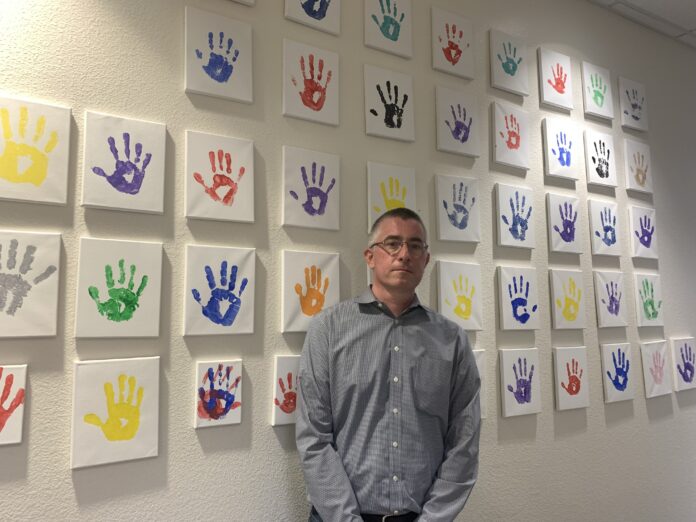UNLV’s Immigration Clinic, which focuses on defending unaccompanied children facing deportation, plans to move to a more accessible location off campus to better serve the community.
The clinic already initiated leasing contracts for the more centralized location, but awaits their finalization to make an official announcement. In addition to the relocation, the clinic looks to double their current staff of three attorneys by next year. It received $1 million in grants from the local government earlier in 2021 allowing them to relocate and expand.
Those currently looking for the clinic tucked inside the William S. Boyd School of Law on the 358-acre UNLV Campus have to maneuver through a maze of educational buildings and plan to walk for several minutes from the limited parking spaces.
“For an undocumented person, who is bringing their 10-year-old who needs legal assistance and has there back up against the wall, we don’t want them to go through the stress of trying to find us on campus,” said Michael Kagan, Director of the UNLV Immigration Clinic. “We want to be in a place that we are closer to the public we’re serving and then we want to bring students there, too.”
UNLV established the clinic in 2003 to teach law students how to defend an immigration case. The university never designated the clinic as a major service provider. A decade later the clinic transitioned into the chief gratuitous immigration counsel for those in our community fighting to stay in the country.
“In 2014, we applied for the Justice Americorp Program to provide stipends to hire law students right out of law school to represent unaccompanied children who had been fleeing violence in central America. Two of our recent students at the time came on board,” Kagan said. “Suddenly we went from having 25 cases active to having 100 cases active with really high stakes and with a lot of visibility.”
The increase in cases for the clinic also rose due to the influx of unaccompanied children fleeing violence, as well as the lack of rights when it comes to legal representation in immigration court.
“As things evolved we became the only program that only made deportation defense a specific focus for free legal systems. We are not the only ones who do it to be clear,” Kagan said. “But we’re the only ones who make deportation defense a specific focus especially when you look at people in detention.”
Local immigration court rooms also recognized the need for representation. As the UNLV Immigration Clinic’s legal team grew, the court provided a flyer with a list of local legal resources to the unrepresented children that included the clinic’s information.
“You’d have these rows of children who were showing up to their hearing in front of the judge and had absolutely nobody with them. No representation, not even their parents,” said Martha Arellano, UNLV Immigration Clinic’s Legal Secretary. “Because their parents, well if their parents were with them they couldn’t go into the immigration court because of their legal status. So you see these kids just sitting there waiting to speak to the judge, just terrified.”
Clients depend on the continuation of the program given the complexity and length of most cases. The process can take multiple years to receive permanent residence. Many of the children helped by the clinic age into legal adults before it happens.
“From what I understand they have so many applications and only so many green cards available to hand out each year. When they reach their limit, whoever is next has to wait for the next availability and that just takes years,” Arellano said. “I think right now they’re working on applications that were submitted in 2016.”
Due to the instability of governments and violence in emigrated countries, clinic employees see the outcomes of the cases as matters of life or death. The impact that they have carries a great weight.
Kagan said delivering the news to a family that their parents are being deported is especially difficult. The immigration judge makes a swift decision and an entire family is immediately devastated.
“It felt like talking to someone when their relative had died because they couldn’t even go hug him and say goodbye,” Kagan said. “We’ve been living in an era where immigrants are not treated as full humans and there’s a great deal of racism. We are trying to lessen the harm until I hope as a society we can become more welcoming.”
Fortunately, although most cases take several years to resolve, the clinic’s successes significantly outweigh their losses. They commemorate every child that is able to achieve legal residence.
“When we are able to have a success story where someone is granted asylum or granted their resident card even if it’s after three, four or five years that is an amazing feeling.” Arellano said. “We feel like we have made a difference in one person’s life. The difference that we make in these people’s lives is life changing. It’s a matter of life and death. This is not just something on a whim— Oh, I want to go and I chose to live here or I chose to live there — No these are people that have actually fled because their lives were in danger.”
When someone officially attains legal status, clinic employees commemorate the moment with a paint imprinting of their single handprint on a white canvas. The handprints hang together on display, five hallway-long rows of bright colored hands. One of the canvases uniquely depicts the hands of both a young mother and her baby who received permanent residence together.
“When you get something successful, you get an asylum or you get a green card for a child or an adult,” Arellano said. “It makes every bad day worth it.”
Given the clinic’s wide success in the community thus far, they received newly awarded funds. The clinic’s history with strategic planning proves that they can expand their humanitarianism through their new initiatives and further solidify their legacy.

